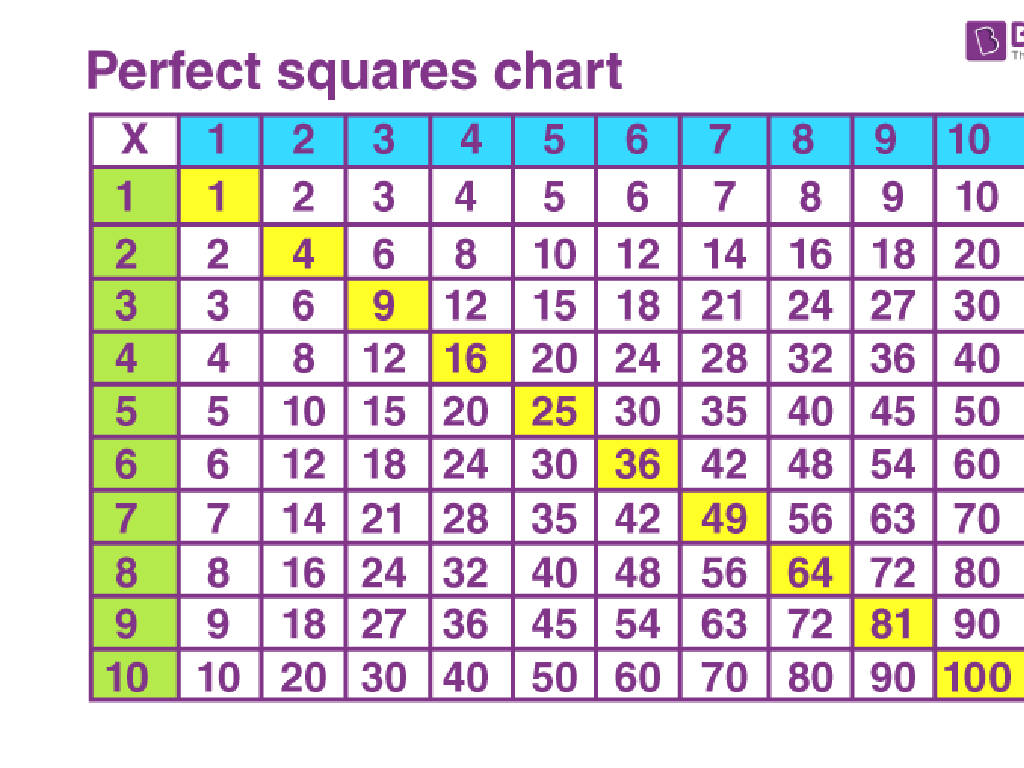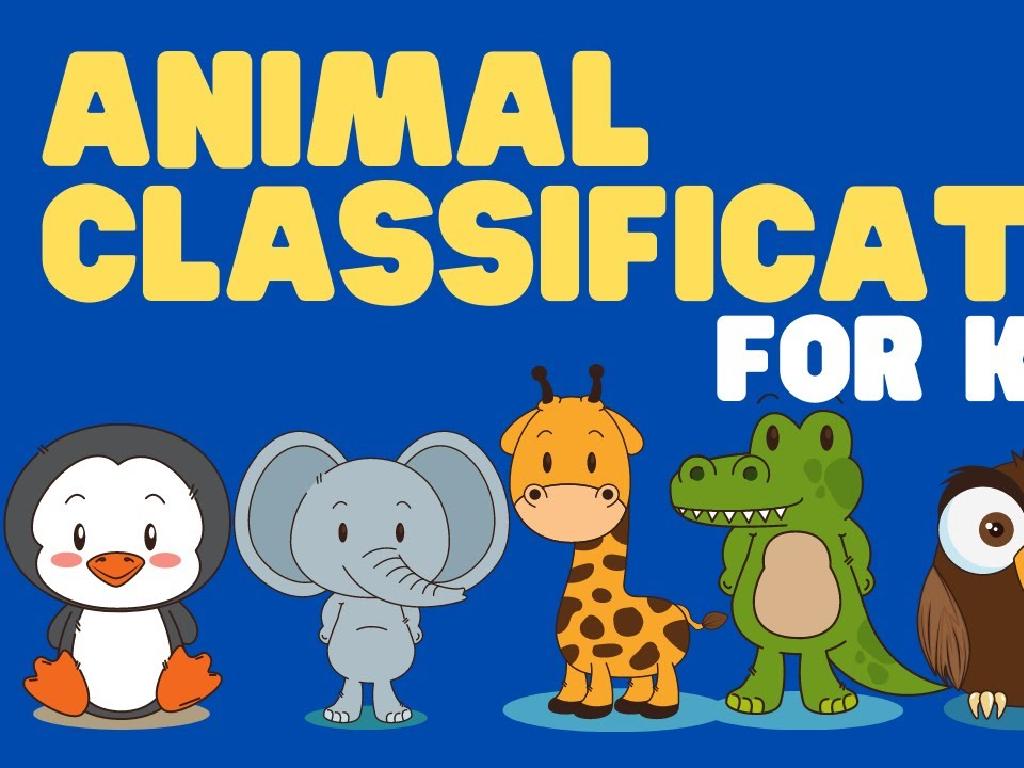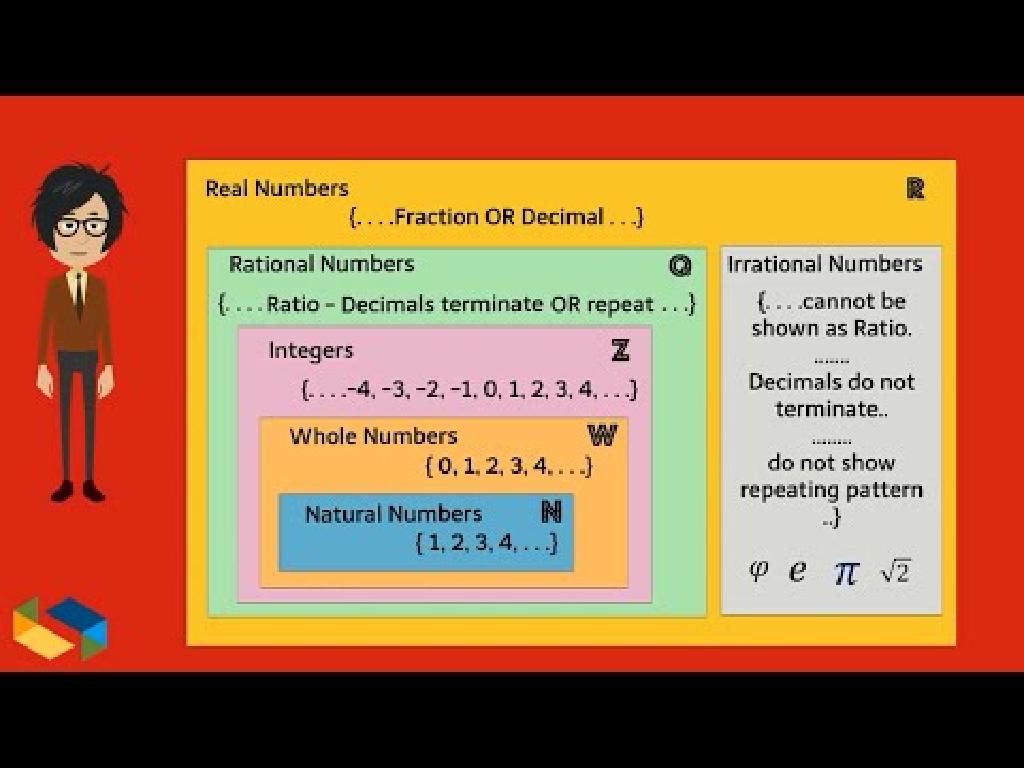Add Mixed Numbers With Like Denominators
Subject: Math
Grade: Fourth grade
Topic: Add And Subtract Fractions With Like Denominators
Please LOG IN to download the presentation. Access is available to registered users only.
View More Content
Introduction to Mixed Numbers
– Understanding fractions & whole numbers
– Fractions represent parts of a whole, while whole numbers are complete units.
– Defining mixed numbers
– Mixed numbers combine whole numbers and fractions, like 2 1/3.
– Mixed numbers in daily life
– Examples: 1 1/2 hours of play, 3 3/4 pizzas for dinner.
– Practice with real examples
|
Begin by explaining the concept of fractions as parts of a whole and whole numbers as complete units. Introduce mixed numbers as a combination of the two, with examples to illustrate their use in everyday life, such as cooking or telling time. Emphasize that the denominator in a mixed number tells us how many parts make up a whole, and the numerator tells us how many parts we have. Encourage students to think of situations where they encounter mixed numbers. Conclude with practice problems that involve adding mixed numbers with like denominators to solidify their understanding.
Recap: Adding Fractions with Like Denominators
– Review adding same denominator fractions
– Denominator remains unchanged
– Example: Add 1/4 + 2/4
– Combine numerators: 1+2, keep denominator: 4
– Simplify the result
– Simplify 3/4 to its lowest terms if needed
|
Begin with a quick recap of adding fractions that have the same denominator, emphasizing that the denominator stays the same throughout the process. Use the practice problem 1/4 + 2/4 to illustrate this concept. Show students how to add the numerators together while keeping the denominator constant. After obtaining the sum of the numerators, guide them to simplify the fraction if possible. This exercise will reinforce their understanding of fraction addition and prepare them for adding mixed numbers with like denominators.
Understanding Like Denominators
– ‘Like Denominators’ explained
– Denominators are the same in ‘like denominators’
– Importance in mixed numbers
– It simplifies adding fractions, ensuring pieces are the same size
– Visual examples provided
– Pictures of pie slices with equal parts to demonstrate
– Practice with real examples
– Use examples like 2 1/4 + 3 1/4 to apply the concept
|
This slide introduces the concept of like denominators, which is crucial for adding mixed numbers. Explain that ‘like denominators’ means the denominators in the fractions are the same, making it easier to combine them since they represent the same-sized parts. Use visual aids like pie charts or bar models to show how like denominators look and why they are necessary for adding mixed numbers. Provide real-life examples, such as combining pieces of pie, to help students understand and apply the concept. Encourage students to practice with examples and prepare a few problems for them to solve as a class.
Adding Mixed Numbers with Like Denominators
– Add whole numbers first
– Combine the whole number parts
– Then add the fractions
– Add the numerators, keep the denominator same
– Simplify the fraction
– If the fraction is improper, convert it
|
This slide introduces the steps to add mixed numbers when the denominators are the same. Start by adding the whole numbers. For example, if we have 2 1/4 + 3 1/4, we first add 2 + 3. Next, we add the fractions by combining the numerators while keeping the denominator unchanged. In our example, 1/4 + 1/4 equals 2/4. If the resulting fraction can be simplified or is improper (the numerator is larger than the denominator), we convert it to a mixed number. For instance, 2/4 simplifies to 1/2, and if we had 5/4, we would convert it to 1 1/4. Encourage students to practice these steps with various examples and ensure they understand each part of the process.
Adding Mixed Numbers with Like Denominators
– Example: 2 1/3 + 3 1/3
– Step-by-step solution
– Add whole numbers: 2 + 3 = 5. Add fractions: 1/3 + 1/3 = 2/3.
– Denominators remain constant
– Like denominators mean the same type of parts.
– Sum of whole numbers and fractions
– Combine sums: 5 + 2/3 = 5 2/3.
|
Begin with the example problem on the board, showing both the whole number and the fractional parts. Explain that when adding mixed numbers with like denominators, we add the whole numbers and the fractions separately. Emphasize that the denominators represent the same parts of a whole, which is why they stay the same when adding. After adding the whole numbers and fractions separately, combine them to find the final sum. Encourage students to practice this method with different numbers, ensuring they understand the concept of like denominators and the process of combining whole numbers and fractions.
Practice Time: Adding Mixed Numbers
– Add whole numbers first: 1 + 2 and 4 + 1
– Add fractions: 2/5 + 2/5 and 3/8 + 1/8
– Like denominators mean we keep the denominator the same
– Combine the sums for final answer
– Ensure the sum of the whole numbers and fractions are combined
– Simplify if needed
– If the fraction is improper, convert it to a mixed number
|
This slide is for a class activity where students will practice adding mixed numbers with like denominators. Start by adding the whole numbers together for each problem. Then, add the fractions, ensuring that the denominators are the same. Combine these sums to get the final answer. If the fraction part of the answer is improper (the numerator is larger than the denominator), teach students how to convert it back into a mixed number. For example, if the fraction sum is 7/5, it should be converted to 1 2/5. Encourage students to simplify their answers if possible. Possible activities include solving these problems on the board, in pairs, or in small groups, using manipulatives for a visual understanding, or creating their own mixed number addition problems.
Class Activity: Mixed Number Addition Race
– Pair up and solve mixed number problems
– Present your problem on the board
– Class checks answers collectively
– Understand mixed number addition
– Adding mixed numbers with the same denominator, like 2 1/3 + 3 1/3
|
This activity is designed to encourage collaboration and active participation. Students will work in pairs to solve problems involving the addition of mixed numbers with like denominators, which reinforces their understanding of the concept. Each pair will have the opportunity to present their solution to the class, promoting public speaking and confidence in math skills. As a class, we will review each solution to ensure understanding and correct any mistakes. This peer-review process is valuable for learning. Prepare several mixed number addition problems in advance, ensuring they all have like denominators. Consider creating a fun, competitive atmosphere by timing the activity or offering small rewards for correct answers to motivate the students.
Wrapping Up: Adding Mixed Numbers
– Review of mixed number addition
– Sum of wholes plus sum of fractions
– Homework: 10 problem worksheet
– Apply today’s lesson at home
– Remember: Practice is key!
– Keep practicing for mastery
– Consistent practice improves skills
|
As we conclude today’s lesson on adding mixed numbers with like denominators, remind students of the key steps: first, add the whole numbers together, and then add the fractions. Distribute the homework worksheet which consists of 10 problems for them to solve, reinforcing the day’s learning. Emphasize the importance of practice in mastering math concepts, and encourage them to try additional problems if they finish early. The goal is for students to feel comfortable with the process and to recognize patterns in mixed number addition.






